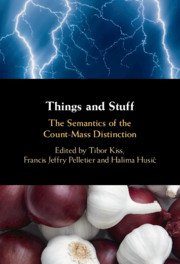Book contents
- Things and Stuff
- Things and Stuff
- Copyright page
- Dedication
- Contents
- Figures
- Tables
- Contributors and their Affiliations
- Preface
- 1 Editorial Introduction: Background to the Count–Mass Distinction
- Large-Scale Architectures for Count and Mass
- 2 Mass vs. Count: Where Do We Stand? Outline of a Theory of Semantic Variation
- 3 Counting, Plurality, and Portions
- 4 Count–Mass Asymmetries: The Importance of Being Count
- 5 Divide and Counter
- Implications from Individual Languages
- Compositional Analyses and Theoretical Issues
- New Empirical Approaches to the Semantics of the Count–Mass Distinction
- References
- Language Index
- Subject Index
3 - Counting, Plurality, and Portions
from Large-Scale Architectures for Count and Mass
Published online by Cambridge University Press: 21 May 2021
- Things and Stuff
- Things and Stuff
- Copyright page
- Dedication
- Contents
- Figures
- Tables
- Contributors and their Affiliations
- Preface
- 1 Editorial Introduction: Background to the Count–Mass Distinction
- Large-Scale Architectures for Count and Mass
- 2 Mass vs. Count: Where Do We Stand? Outline of a Theory of Semantic Variation
- 3 Counting, Plurality, and Portions
- 4 Count–Mass Asymmetries: The Importance of Being Count
- 5 Divide and Counter
- Implications from Individual Languages
- Compositional Analyses and Theoretical Issues
- New Empirical Approaches to the Semantics of the Count–Mass Distinction
- References
- Language Index
- Subject Index
Summary
It is often assumed that plurality and countability are necessarily related. One way of expressing this might be as follows: Counting the number of cats involves determining how many individual cats there are. “There are four cats on the sofa” is true if the plural individual on the sofa is made up of four discrete, non-overlapping single individual cats. It is thus natural that the set of individual cats is grammatically salient and marked in contrast to the plural set. Since we do not count mud, and mud does not come in inherently individuable stable units, there is no set denoting single units of mud and the singular/plural contrast is not relevant. In We ordered here two coffees, three beers and one water the plural marker indicates that the noun has shifted to a count interpretation. Theories differ as to why mud is mass and why, unlike coffee or water, it cannot shift to a count interpretation, but the assumption that the lack of countability and the lack of pluralization are related is pretty widely assumed. The goal of this paper is to explore the relation between countability and plurality, especially in examples like the one with two coffees, three beers, one water.
Keywords
- Type
- Chapter
- Information
- Things and StuffThe Semantics of the Count-Mass Distinction, pp. 55 - 80Publisher: Cambridge University PressPrint publication year: 2021
- 2
- Cited by



